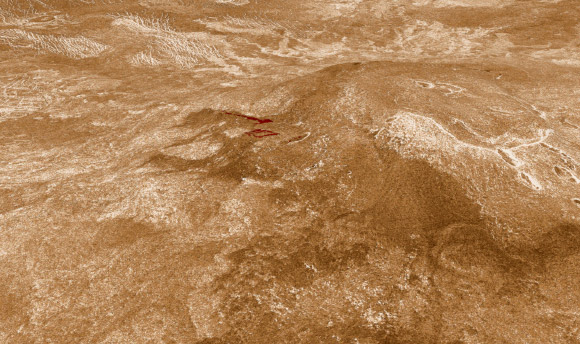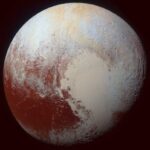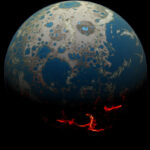Using radar data from NASA’s Magellan mission, planetary scientists have detected volcanic-related flow features in two different regions of Venus: on the western flank of Sif Mons and in western Niobe Planitia.
This image shows the Sif Mons area with the active volcanic region highlighted in red. Image credit: Davide Sulcanese, IRSPS – Università d’Annunzio.
Venus’ thick atmosphere has made it difficult to directly observe the surface of the planet.
However, global radar mapping performed in the 1990s by the Magellan spacecraft showed that Venus’ surface is covered with many volcanoes and has likely been shaped by widespread volcanic activity in its past — though the role of volcanism in the planet’s geologic present remained unclear.
However, evidence of more recent activity from one volcanic vent on the planet’s surface was identified in the Magellan data in 2023.
In the new study, d’Annunzio University researcher Davide Sulcanese and his colleagues analyzed two sets of Magellan radar data obtained in 1990 and 1992 to look for evidence of volcanic activity.
They found surface changes that could indicate volcanism in two areas where volcanic-related features are present, located on the western flank of Sif Mons and in western Niobe Planitia.
After analyzing the various possible sources, the authors suggest that these variations were likely caused by fresh lava flows.
They suggest that Venus is a geologically active planet in the present day, but also that present-day volcanism is rather widespread.
They also suggest that volcanic activity on Venus is comparable to that of Earth, indicating that Venus is more volcanically active than previously thought.
“Using these maps as a guide, our results show that Venus may be far more volcanically active than previously thought,” Dr. Sulcanese said.
“By analyzing the lava flows we observed in two locations on the planet, we have discovered that the volcanic activity on Venus could be comparable to that on Earth.”
“We interpret these signals as flows along slopes or volcanic plains that can deviate around obstacles such as shield volcanoes like a fluid,” added Dr. Marco Mastrogiuseppe, a researcher at Sapienza University of Rome.
“After ruling out other possibilities, we confirmed our best interpretation is that these are new lava flows.”
“These new discoveries of recent volcanic activity on Venus provide compelling evidence of the kinds of regions we should target with NASA’s upcoming VERITAS mission when it arrives at Venus,” said Dr. Suzanne Smrekar, a researcher at NASA’s Jet Propulsion Laboratory and principal investigator for VERITAS.
“Our spacecraft will have a suite of approaches for identifying surface changes that are far more comprehensive and higher resolution than Magellan images.”
“Evidence for activity, even in the lower-resolution Magellan data, supercharges the potential to revolutionize our understanding of this enigmatic world.”
The results were published this week in the journal Nature Astronomy.
_____
D. Sulcanese et al. Evidence of ongoing volcanic activity on Venus revealed by Magellan radar. Nat Astron, published online May 27, 2024; doi: 10.1038/s41550-024-02272-1





